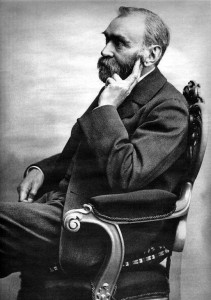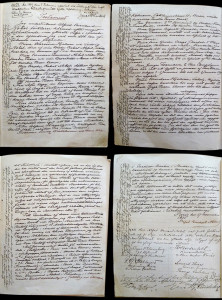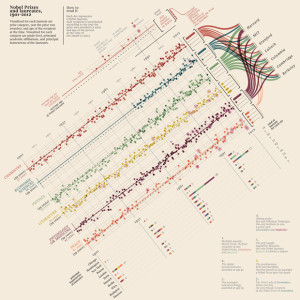How the Nobel Prize Was Born: A Surprising Story of Bad Journalism, Existential Guilt, and Dynamite
HISTORY, 30 Sep 2013
Maria Popova, Brain Pickings – TRANSCEND Media Service
How a deplored “tradesman of death” brought to life the highest accolade of human achievement.
The only thing more interesting than the colorful history of Nobel Prize laureates — including such remarkable humans as Marie Curie, not only the first woman to win a Nobel Prize but also the only person to date to win a Nobel in two different sciences, Aung San Suu Kyi, the only laureate who received the prize while under house arrest, and Ernest Hemingway, whose acceptance speech is prize-worthy in its own right — is the founding story of the Nobel Prize itself.
The striking yet little-known origin of the prize is one of the many curiosities journalist and museum aficionado Molly Oldfield hunts down in The Secret Museum (public library) — a boundlessly fascinating inventory of sixty never-before-seen “treasures too precious to display,” culled from the archives and secret storage locations of some of the world’s top cultural institutions, from London’s Royal Society, wherein a piece of Newton’s apple tree is painstakingly preserved, to New York’s Morgan Library, which houses an original Gutenberg Bible printed on vellum, to Nabokov’s cabinet of butterfly genitalia held at Harvard.
From Olov Amelin, curator of Stockholm’s Nobel Museum, Oldfield learns that the revered Nobel Prize — held today as an echelon of celebrating the human spirit at its highest potential — has a rather dark origin of destruction and confusion. In 1888, when a humble Swede by the name of Ludwig Nobel died, the French press confused him with his younger brother Alfred — the famed Swedish entrepreneur and inventor who amassed his fortune by making such deadly delights as dynamite and ballistic — and ran an eviscerating epitaph about this “Tradesman of Death.” Alfred Nobel, having the rare misfortune of witnessing his legacy while still alive, found himself heartbroken and determined to change his story before it was too late. Likening his tale to that of Scrooge in A Christmas Carol, Oldfield writes:
Nobel had a vision of the future that might be, and he decided to change his destiny.
He thought for a while about what to do. Then, on November 27, 1895, he took action. He went to the Swedish Norwegian Club in the Marais in Paris, sat down at a writing desk — which is still there (the venue is now called simply the Swedish Club) — and wrote his last will and testament.
Over four pages, he set out what he wanted to give to his relatives — he had no children — and to his staff. He asked that the rest of his estate be invested into a fund, “the interest on which shall be annually distributed in the form of prizes to those who, during the preceding year, shall have conferred the greatest benefit to mankind.”
The interest was to be divided into five equal parts and each part given to the person who had made the most important discovery each year in four fields and, finally, “one part to the person who shall have done the most or the best work for fraternity between nations, for the abolition or reduction of standing armies and for the holding and promotion of peace congress” — the Nobel Peace Prize.
This is the translation of the passage from Nobel’s will outlining the ideals and practical execution of the prize:
The whole of my remaining realizable estate shall be dealt with in the following way: the capital, invested in safe securities by my executors, shall constitute a fund, the interest on which shall be annually distributed in the form of prizes to those who, during the preceding year, shall have conferred the greatest benefit to mankind. The said interest shall be divided into five equal parts, which shall be apportioned as follows: one part to the person who shall have made the most important discovery or invention within the field of physics; one part to the person who shall have made the most important chemical discovery or improvement; one part to the person who shall have made the most important discovery within the domain of physiology or medicine; one part to the person who shall have produced in the field of literature the most outstanding work in an ideal direction; and one part to the person who shall have done the most or the best work for fraternity between nations, for the abolition or reduction of standing armies and for the holding and promotion of peace congresses. The prizes for physics and chemistry shall be awarded by the Swedish Academy of Sciences; that for physiological or medical work by the Caroline Institute in Stockholm; that for literature by the Academy in Stockholm, and that for champions of peace by a committee of five persons to be elected by the Norwegian Storting. It is my express wish that in awarding the prizes no consideration whatever shall be given to the nationality of the candidates, but that the most worthy shall receive the prize, whether he be a Scandinavian or not.
The will, which is now kept in a vault at the Nobel Foundation in Stockholm and has never been on display, was so impromptu that Nobel asked four random gentlemen who happened to be in the Club that day to witness the document. When he died the following year, his 25-year-old assistant Ragnar Sohlman was entrusted with executing Nobel’s wishes. Oldfield captures the young man’s relentless dedication to his task:
He raced around Paris in a horse-drawn carriage, collecting cash, papers and bonds from different banks. He packed everything into boxes and shipped it to Sweden, from the Gare du Nord, Paris, as registered luggage. Back in Sweden, he began slowly to sell Nobel’s shares, so the companies he had been invested in didn’t crash.
And yet Nobel’s will was met with enormous resistance at first. His relatives, completely unaware of his plan, were shocked. The Swedish royal family condemned him for being unpatriotic by setting up a nationality-blind prize fund rather than rewarding Swedes only. His staff was outraged by the enormous administrative and organizational costs of such an operation, which they thought Nobel didn’t consider when he made his will. But the idea also stirred quite a few hearts:
The Olympics were happening in Greece in 1896 and there was a general sense of wanting to create a world family and to honor people who were helping mankind. Ragnar found more and more support as he worked steadily to set up the Nobel Foundation, and to make Nobel’s wishes a reality. In 1901, five years after Nobel’s will was first read, the first Nobel Prizes were awarded in Sweden and Norway. A century later, the museum opened in Stockholm.
Today, it gives one pause to consider that the highest honor of human achievement owes its origin to a combination of journalistic error and existential guilt. The more cynical might say that Alfred Nobel was exercising an especially grandiose form of vanity, but cynicism has no place in the spirit of the Prize, so in honoring that, let’s instead acknowledge that altruism has always been a tricky subject and that the desire to leave something meaningful behind, rather than a form of vanity, is among the universal longings of the human condition.
The Secret Museum is astonishing — quite literally — in its entirety, unraveling such scrumptious and surprising curiosities as Van Gogh’s unseen sketchbooks, the tools that belonged to Queen Victoria’s dentist, and Winston Churchill’s sketches.
______________________
Brain Pickings is the brain child of Maria Popova, an interestingness hunter-gatherer and curious mind at large obsessed with combinatorial creativity who also writes for Wired UK and The Atlantic, among others, and is an MIT Futures of Entertainment Fellow. She has gotten occasional help from a handful of guest contributors.
Go to Original – brainpickings.org
DISCLAIMER: The statements, views and opinions expressed in pieces republished here are solely those of the authors and do not necessarily represent those of TMS. In accordance with title 17 U.S.C. section 107, this material is distributed without profit to those who have expressed a prior interest in receiving the included information for research and educational purposes. TMS has no affiliation whatsoever with the originator of this article nor is TMS endorsed or sponsored by the originator. “GO TO ORIGINAL” links are provided as a convenience to our readers and allow for verification of authenticity. However, as originating pages are often updated by their originating host sites, the versions posted may not match the versions our readers view when clicking the “GO TO ORIGINAL” links. This site contains copyrighted material the use of which has not always been specifically authorized by the copyright owner. We are making such material available in our efforts to advance understanding of environmental, political, human rights, economic, democracy, scientific, and social justice issues, etc. We believe this constitutes a ‘fair use’ of any such copyrighted material as provided for in section 107 of the US Copyright Law. In accordance with Title 17 U.S.C. Section 107, the material on this site is distributed without profit to those who have expressed a prior interest in receiving the included information for research and educational purposes. For more information go to: http://www.law.cornell.edu/uscode/17/107.shtml. If you wish to use copyrighted material from this site for purposes of your own that go beyond ‘fair use’, you must obtain permission from the copyright owner.


